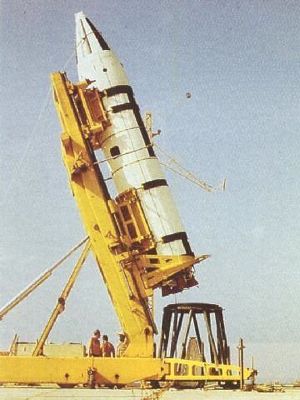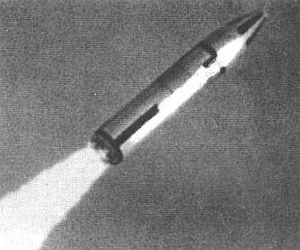
Home - Search - Browse - Alphabetic Index: 0- 1- 2- 3- 4- 5- 6- 7- 8- 9
A- B- C- D- E- F- G- H- I- J- K- L- M- N- O- P- Q- R- S- T- U- V- W- X- Y- Z
Alfa
 Alfa Missile Credit: Giuseppe Di Chiara |
Status: Retired 1976. First Launch: 1973-02-01. Last Launch: 1976-04-06. Number: 6 . Payload: 1,000 kg (2,200 lb). Thrust: 250.00 kN (56,200 lbf). Gross mass: 8,000 kg (17,600 lb). Height: 6.50 m (21.30 ft). Diameter: 1.37 m (4.49 ft). Apogee: 300 km (180 mi).
In the early 1960's Italy found itself surrounded by states pursuing nuclear weapons. Yugoslavia and Rumania had begun independent development of atomic bombs and collaborated in the design and development of the Orao strike aircraft. Switzerland had decided to pursue nuclear weapons on 23 December 1958. By 4 May 1964 the Swiss military joint staff issued a recommendation to have 250 nuclear weapons, including 100 on rockets, by 1980. Italy, for its part, modified the 1930s-era Cruiser Giuseppe Garibaldi with four launch tubes for Polaris missiles. It was Italy's intention to equip them with American nuclear weapons under the NATO Multilateral Nuclear Force (MLF) concept. Polaris missiles were supplied by the United States and were flight tested from the Garibaldi during the mid-1960's.
But by that time the United States had as a higher priority the prevention of nuclear proliferation. The Soviet Union made elimination of the NATO MLF a precondition to signing the Nuclear Non-proliferation Treaty. The treaty went into force in 1968, but notably Switzerland, the Balkan states, and Italy did not immediately ratify it. Switzerland signed the treaty in 1969, and Yugoslavia and Rumania ratified by March 1970, but intelligence indicated that Yugoslavia was still pursuing development of nuclear weapons at the Vinca Institute near Belgrade. Therefore it did not seem that Italy's security could be guaranteed.
Italy decided to take steps toward an independent nuclear deterrent. The project for an indigenous Italian ballistic missile was begun in 1971 by the Navy. Officially it was called a 'technology program intended to develop high power solid-propellant boosters for civil and military applications'. The resulting missile was to be carried on submarines and major surface combatants.
The first stage motor was fired eight times in static tests. Three Alfa test missiles with inert second stages were launched, in September and October 1975 and April 1976 from Salto di Quirra in Sardinia. (Another source gives February 1973, Winter 1974, and 4 April 1975). All flights were successful.
The program was abandoned at this stage. Yugoslavia's nuclear program was winding down, and under US pressure Italy had signed the Nuclear Non-proliferation Treaty on 2 May 1975. Switzerland ratified the treaty and definitively ended its under-funded nuclear program in 1977.
Technical Description
The first stage was 3.845 m long and used 6050 kg of solid fuel with a five-pointed star grain (HTPB with 12% aluminum, 15% binder and 73% ammonium perchlorate). The stage had four gimbaled nozzles made of carbon with a graphite throat. Burn time was 57 seconds, indicating a lift-off thrust of around 25 metric tons. The second stage had a mass of 950 kg. The Alfa would have been capable of sending a one metric ton warhead to a range of 1600 km, sufficient to strike Moscow and other targets in European Russia from the Adriatic.
Alfa prime contractor was Aeritalia (now Alenia), with BPD Spazio providing the engine, Selenia the ground range tracking, and Sistel the on-board electronics. Other contractors included Laben and Motofides/Whitehead. The technological heritage of Alfa lived on in continuing Italian interest in light solid-propellant space launchers, including Advanced Scout and the current Vega project.
Many thanks to Paolo Ulivi, Giovanni di Chiara, and Allen Thomson for tracking down information on this 'unknown' rocket...
Maximum range: 1,000 km (600 mi).
Family: IRBM, submarine-launched. Country: Italy. Launch Sites: Salto di Quirra. Stages: Alfa engine. Agency: Alenia. Bibliography: 2, 432, 433.
 | Alfa rocket |
1959 January 3 - . Launch Vehicle: Alfa.
- Switzerland decided to pursue development of nuclear weapons - . Nation: Switzerland.
1964 May 4 - . Launch Vehicle: Alfa.
- Swiss military joint plans for nuclear warhead ballistic missiles. - . Nation: Switzerland. Swiss military joint staff issued a recommendation to have 250 nuclear weapons, including 100 on rockets, by 1980..
1971 - . Launch Vehicle: Alfa.
- Alfa SLBM project begun. - .
Nation: Italy.
The project for an indigenous Italian ballistic missile was begunby the Italian Navy. Officially it was called a 'technology program intented to develop high power solid-propellant boosters for civil and military applications'. The resulting missile was to be carried on submarines and major surface combatants.
1973 February 1 - . Launch Site: Salto di Quirra. Launch Vehicle: Alfa.
- Spurious? - . Nation: Italy. Apogee: 50 km (31 mi). First test flight of Italian submarine- and ship-launched ballistic missile. Dummy second stage. Successful 57 second flight..
1974 Q4 - . Launch Site: Salto di Quirra. Launch Vehicle: Alfa.
- Spurious? - . Nation: Italy. Apogee: 50 km (31 mi). Second test flight of Italian submarine- and ship-launched ballistic missile. Dummy second stage..
1975 April 4 - . Launch Site: Salto di Quirra. Launch Vehicle: Alfa.
- Spurious? - . Nation: Italy. Apogee: 50 km (31 mi). Final test flight of Italian submarine- and ship-launched ballistic missile. Dummy second stage. Project cancelled after Italy ratified Nuclear Non-Proliferation Treaty and decided to give up pursuit of an independent nuclear deterrent..
1975 May 2 - . Launch Vehicle: Alfa.
- Alfa SLBM program cancelled - . Nation: Italy. Under US pressure Italy had signed the Nuclear Non-proliferation Treaty on 2 May 1975. Work on nuclear-tipped ballistic missiles ended..
1975 September 8 - . Launch Site: Salto di Quirra. Launch Vehicle: Alfa.
- Nation: Italy. Apogee: 110 km (60 mi).
1975 October 23 - . Launch Site: Salto di Quirra. Launch Vehicle: Alfa.
- Nation: Italy. Apogee: 100 km (60 mi).
1976 April 6 - . 14:46 GMT - . Launch Site: Salto di Quirra. Launch Vehicle: Alfa.
- Nation: Italy. Apogee: 100 km (60 mi).
1977 March 9 - . Launch Vehicle: Alfa.
- Switzerland definitively ended its nuclear-tipped rocket program. - . Nation: Switzerland. Switzerland ratified the nuclear non-proliferation treaty and ended its under-funded nuclear program..
Back to top of page
Home - Search - Browse - Alphabetic Index: 0- 1- 2- 3- 4- 5- 6- 7- 8- 9
A- B- C- D- E- F- G- H- I- J- K- L- M- N- O- P- Q- R- S- T- U- V- W- X- Y- Z
© 1997-2019 Mark Wade - Contact
© / Conditions for Use